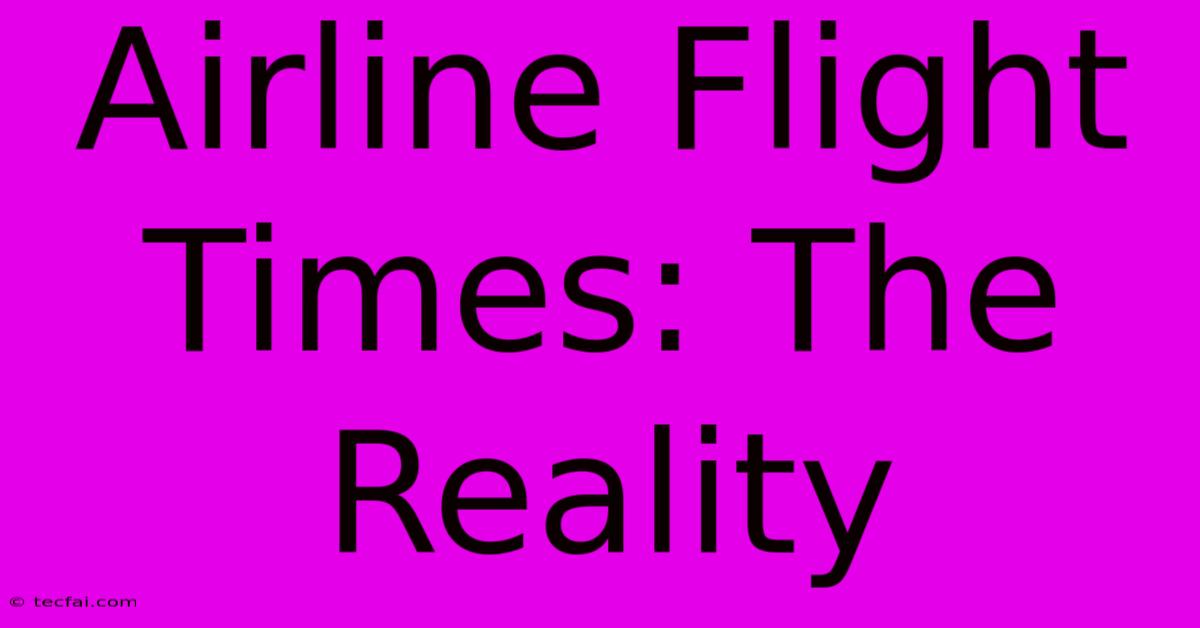Airline Flight Times: The Reality

Discover more detailed and exciting information on our website. Click the link below to start your adventure: Visit Best Website tecfai.com. Don't miss out!
Table of Contents
Airline Flight Times: The Reality—Beyond the Scheduled Departure
So, you've booked your flight, eagerly anticipating your journey. You glance at your itinerary, noting that seemingly perfect flight time. But the reality of airline flight times often differs significantly from the scheduled departure and arrival. This article delves into the factors that contribute to flight delays and cancellations, offering insights into navigating this frustrating, yet common, travel experience.
The Illusion of Precision: Why Scheduled Times Are Just Estimates
Airline schedules are, at best, educated guesses. While meticulously planned, they are subject to a myriad of unpredictable variables. Think of it as a complex equation with many moving parts, each susceptible to unforeseen circumstances. The scheduled flight time represents the ideal scenario, assuming everything runs flawlessly. Sadly, in the world of air travel, “flawlessly” is a rare occurrence.
Major Culprits Behind Flight Delays and Cancellations
Several factors significantly impact flight times, causing delays and even cancellations. Understanding these can help manage expectations and reduce travel stress:
-
Air Traffic Control: Delays caused by air traffic congestion are incredibly common. Think of airports as busy highways in the sky; delays in one area can ripple across the entire network, impacting countless flights. Weather conditions, particularly severe weather, further exacerbate this issue.
-
Mechanical Issues: Aircraft malfunctions are inevitable. While airlines strive for rigorous maintenance, unforeseen mechanical problems can ground planes, leading to significant delays or cancellations. These issues range from minor glitches to major engine failures, necessitating extensive repairs.
-
Weather Conditions: From thunderstorms and heavy snow to fog and strong winds, inclement weather can drastically impact flight operations. Safety is paramount, and flights are often delayed or cancelled to ensure passenger and crew safety. This is particularly true for takeoff and landing, which are the most critical phases of flight.
-
Crew Scheduling: Airline crew members, including pilots and cabin crew, have strict working hours and rest periods governed by regulations. Unexpected delays can push these limits, necessitating crew changes that add further delays. Finding replacement crew can also take considerable time.
-
Airport Operations: Delays can occur within the airport itself due to baggage handling issues, passenger processing bottlenecks, or even security screenings. These seemingly minor setbacks can cascade, impacting subsequent flights.
Navigating the Realities of Flight Delays: Proactive Strategies
While you can’t control external factors, you can take steps to mitigate the impact of flight delays:
-
Travel Insurance: Consider purchasing comprehensive travel insurance that covers flight disruptions, providing compensation for missed connections or accommodation costs.
-
Buffer Time: When planning your itinerary, always build in significant buffer time between connecting flights. Account for potential delays, especially when traveling during peak seasons or to/from busy airports.
-
Flight Tracking Apps: Utilize flight tracking apps to monitor your flight's status in real-time. These apps provide updates on delays, gate changes, and other pertinent information.
-
Airline Alerts: Sign up for email or text alerts from your airline to receive timely updates about your flight.
-
Stay Calm and Patient: Frustration is understandable, but remember that airline staff are usually doing their best to manage challenging situations. Remaining calm and polite increases the likelihood of receiving assistance and support.
Conclusion: Embracing the Unexpected
Airline flight times are rarely precise. Understanding the factors that influence them empowers you to be better prepared for potential disruptions. By adopting a proactive approach and managing expectations, you can significantly reduce stress and enhance your overall travel experience. Remember to always prioritize safety and plan for the unexpected—because in the world of air travel, the unexpected is often the norm.

Thank you for visiting our website wich cover about Airline Flight Times: The Reality. We hope the information provided has been useful to you. Feel free to contact us if you have any questions or need further assistance. See you next time and dont miss to bookmark.
Featured Posts
-
Twala Weer Hof Toe Na Aanhouding
Nov 27, 2024
-
Taylor Swifts Eras Tour Vancouver Economic Impact
Nov 27, 2024
-
Vanderpump Rules Cast Fired Reactions
Nov 27, 2024
-
3 0 Victory For Sheffield United
Nov 27, 2024
-
Feyenoord Fightback 3 3 Draw
Nov 27, 2024
